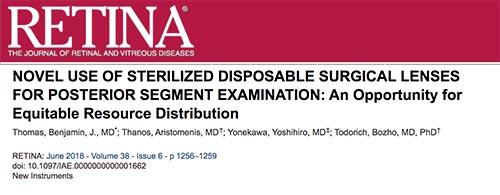About Us: Blog and News RETINA June 2018
New Instruments
Novel Use Of Sterilized Disposable Surgical Lenses for Posterior Segment Examination: An Opportunity for Equitable Resource Distribution
Thomas, Benjamin, J., MD*; Thanos, Aristomenis, MD†; Yonekawa, Yoshihiro, MD‡; Todorich, Bozho, MD, PhD†
RETINA: June 2018 - Volume 38 - Issue 6
Author Information
*Florida Retina Institute, Jacksonville, Florida; 
†William Beaumont Hospital, Oakland University School of Medicine, Royal Oak, Michigan; and
‡Massachusetts Eye and Ear Infirmary, Harvard Medical School, Boston, Massachusetts.
None of the authors has any financial/conflicting interests to disclose.
Link to the article
Global provision of adequate medical care is an immense challenge, and one of its greatest inherent obstacles is the unequal distribution of healthcare workers and resources.1 This reality is readily apparent in variable global access to specialty and subspecialty care, such as those in the category of human resources for eye health—including ophthalmologists, optometrists, and opticians. Evaluations of the global distribution of eye health workers reveal immense differences, 2-8 with an almost 10-fold difference in the average number of practicing ophthalmologists per million between low- and high-income countries (mean: 8 per million and 79 per million, respectively).2
Restricted access to medications, disposable materials, and diagnostic equipment further compounds the difficulties of providing care in resource-poor settings of low- to middle-income countries.
Numerous reports from various low- to middle-income countries cite poor access to resources as a lead reason for poor delivery of eye care.8-11
The diagnosis and treatment of vitreoretinal disease—including simply viewing the posterior segment for screening purposes—requires a cadre of specialized lights, lenses, and imaging equipment. These inherent costs raise significant barriers for the delivery of retinal care. As such, the retina is often neglected diagnostically, many centers do not have dedicated retinal facilities, and many ophthalmic trainees in low - to middle-income countries are left wanting in terms of vitreoretinal clinical experience.8
Removing these barriers requires finding ways to lower costs, increase acceess to diagnostic resources, and broaden clinical training. We identified one potential means of doing so: disposable lenses for noncontact vitreoretinal surgical platforms, which are discarded after a single use, can be sterilized and repurposed as diagnostic lenses to be used during slit-lamp examination to visualize the macula and peripheral retina.

Technique
The BIOM lens manufactured by OCULUS Optikgeraete GmbH (Wetzlar, Germany) is a polymethyl methacrylate lens designed for wide-angle, non-contact visualization of the posterior segment during surgery. The lens has an asymmetric biconvex form with a diameter of 18 mm and thickness of 11 mm, with a refractive power of 100 diopters. Both reusable and disposable forms are commercially available: the disposable product is designed to be inserted into a sterilized base, used for a single surgery, and then discarded. Click here to continuing reading this article.
About RETINA
About the Journal. RETINA® focuses exclusively on the growing specialty of vitreoretinal disorders. The Journal provides current information on diagnostic and therapeutic techniques. Its highly specialized and informative, peer-reviewed articles are easily applicable to clinical practice. In addition to regular reports from clinical and basic science investigators, RETINA® publishes special features including periodic review articles on pertinent topics, special articles dealing with surgical and other therapeutic techniques, and abstract cards. Issues are abundantly illustrated in vivid full color.
About OCULUS
From Idea to Product
For more than 120 years, OCULUS has been a partner for eye care professionals around the world. With the highest attention to detail, the devices are designed and manufactured in the OCULUS headquarters, located in Wetzlar, Germany. OCULUS has eight subsidiaries in Europe, Asia and America. OCULUS, Inc. (USA) was founded in 1999. Combining the finest German engineering with exceptional customer support. OCULUS understands the importance of continuous operation of your devices: With service centers located in Washington and Florida, OCULUS provides reliable, fast and customer-friendly service from 8 am to 8 pm EST. By developing sophisticated technology-based instruments of the highest quality, OCULUS provides excellent support for the challenging daily tasks eye care professionals encounter. OCULUS provides ongoing training and educational resources, which are accessible 24/7 in our online library or offline during many in house training sessions throughout the year. With the OCULUS products, such as the Pentacam®, Keratograph® 5M, and Easyfield® C, OCULUS has established a gold standard in ophthalmic diagnostic devices. Our customers and their satisfaction is our responsibility.
OCULUS Optikgeräte GmbH - Corporate Profile, https://www.oculus.de/us/from-idea-to-product



